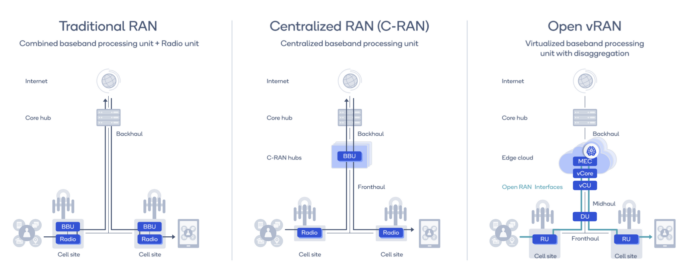To propel Open RAN, vRAN and public and private 5G networks, Qualcomm is drawing on domain expertise in connectivity and low-power compute
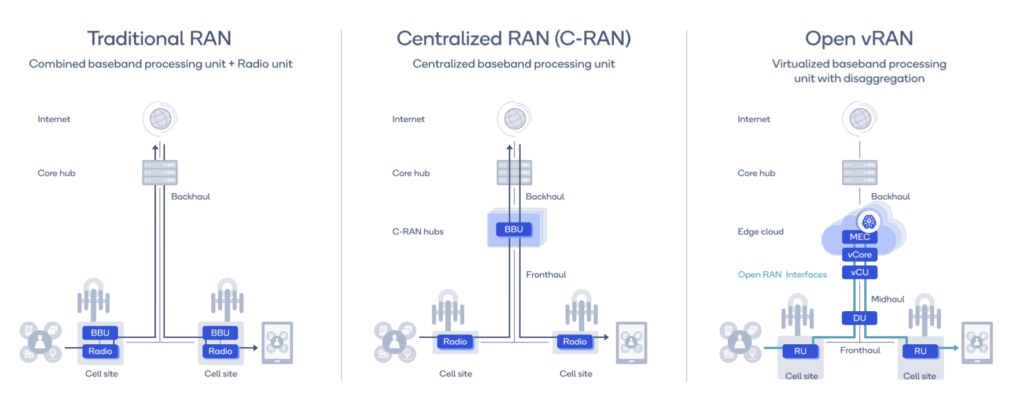
Qualcomm again demonstrated the ongoing strength of its diversification push during Mobile World Congress with a number of partner announcements highlighting the semiconductor specialist’s growth in 5G infrastructure. Building on its established small cell chipset business, Qualcomm is pushing into virtualized and Open RAN technologies, along with service management and orchestration, alongside the likes of Dell Technologies, Mavenir, NEC, Schneider Electric and other major players.
In a media briefing hosted in the Qualcomm stand, Vice President and General Manager of 5G RAN Infrastructure Gerardo Giaretta identified the move to vRAN, Open RAN and public/private network interoperability as major transformations impacting the radio space. From a product perspective, Qualcomm showed at MWC its QRU and QDU platforms, its X100 5G RAN Accelerator Card for L1 processing, a compact macro mmWave radio reference design, and its Edgewise suite for RAN service management and orchestration.
“Our goal,” Giaretta said, “is to enable Open RAN implementations which are as good or better than the traditional implementation. That’s our goal.” Pointing to the need for hardware-based acceleration beyond what generic CPUs can handle for Layer 1 RAN processing, he said, “We are really focusing on what is our main differentiator which is very power efficient systems on chip for lower layer 5G.”
Energy efficient massive MIMO with Mavenir
During the show, Qualcomm announced it worked with Open RAN leader Mavenir to launch the OpenBeam massive MIMO active antenna unit which uses Qualcomm’s 5G radio unit platform, the QRU100. The 32T/32R unit has 320 Watt output power across 192 antenna elements.
Vodafone, which has committed to major Open RAN deployments across its brownfield European footprint through the end of the decade, focused a prepared comment on energy efficiency and performance. “Mavenir’s solution puts Open RAN at the forefront of radio technology, enriches the ecosystem with new players and enables us to deliver a great customer experience,” according to group Head of Open RAN Paco Martin. He said the new OpenBeam antenna “brings a new level of excellence” to massive MIMO products.
Per Giaretta, “It is not the most Open RAN energy efficient solution. It is the most energy efficient solution overall. We are enabling OEMs to really go energy efficient and to enable Open RAN and virtualized RAN with the next generation of power efficiency.” By the numbers, he said the collaboration with Mavenir delivers 60% lower operator TCO and 40% less power consumption.
Hitting the gas with Dell Technologies and NEC
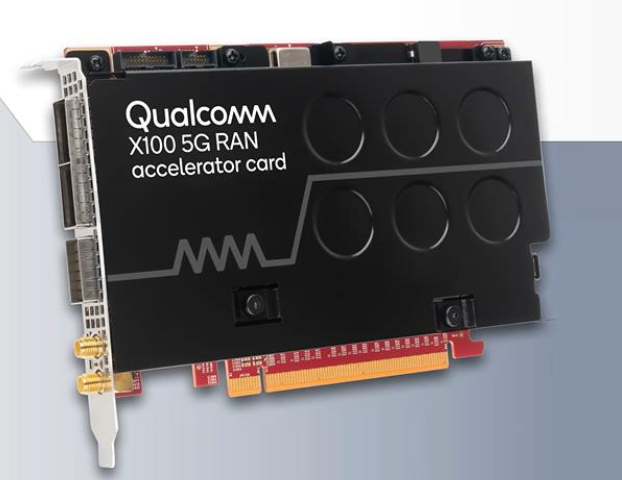
Back to Layer 1 acceleration, Dell Technologies and NEC are both using Qualcomm’s X100 5G RAN Accelerator Card. Dell is putting the card in its PowerEdge servers, acting as virtualized distributed units, and is targeting the Open RAN and private network markets. The idea is lower TCO by offering a pre-integrated and customizable solution that simplifies Open RAN fronthaul and Layer 1 High processing.
Dell’s SVP and GM of the Telecom Systems Business said in a statement, “Layer 1 acceleration is one of the critical innovations required to enable telecom network disaggregation, specifically in the RAN…We’re extending our collaboration with Qualcomm Technologies to develop solutions to make open network deployments more efficient and cost-effective.”
NEC is also using Qualcomm’s X100 in its vDU, building on a relationship announced in November 2021. In addition to the performance/power points, NEC also noted the ability to future-proof investments and extend product lifecycle by supporting rapid adoption of ongoing 3GPP release features.
NEC’s General Manager of vRAN Katsumi Tanoue said the X100 “outperforms others in processing power and low power consumption. We are pleased to offer the vDU solution in combination with NEC’s upper layer software.” NTT DoCoMo is a major NEC customer and was an early and fast mover in Open RAN. DoCoMo’s Vice President and Global Head of Open RAN Sadayuki Abeta said, “A benefit of Open RAN is the capability to introduce technology advancements by combining strengths of multiple companies. We expect to achieve high capacity and power efficient vDU together with NEC and Qualcomm Technologies.”
The big takeaway from Giaretta: “We are completing the implementation of the product and we have partners. They are integrating our solution into theirs…That shows also the openness of our interfaces. We are low power, virtualized and open.”
Orchestration on the edge
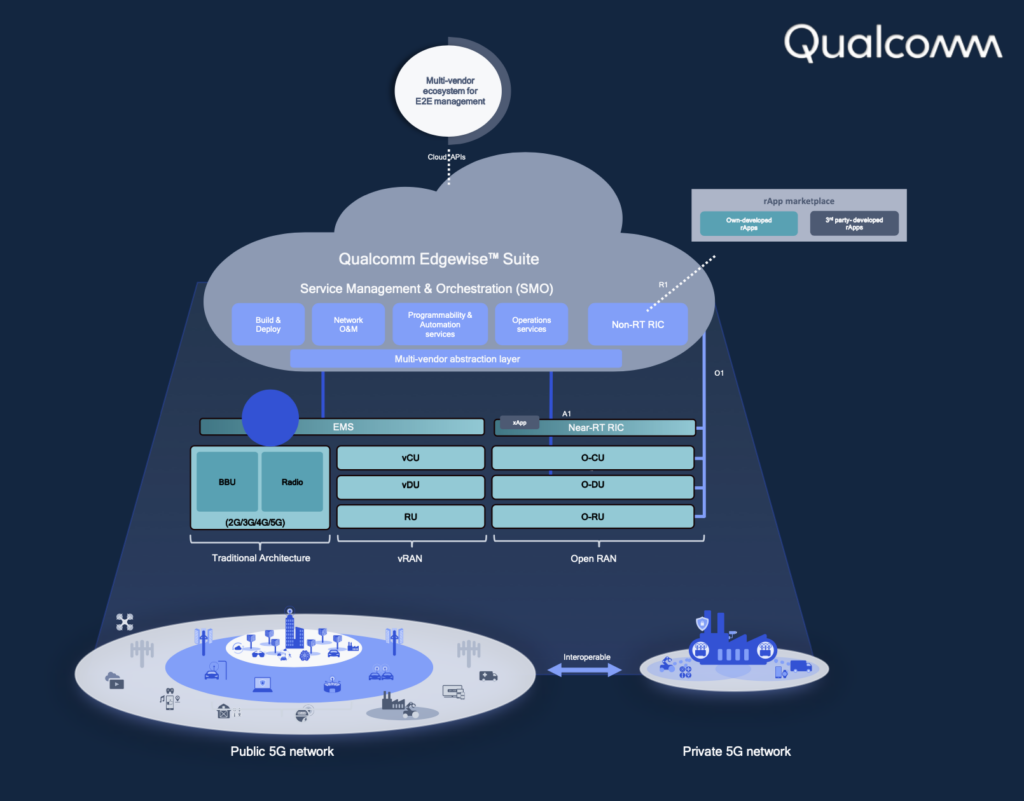
One of the lingering core questions around Open RAN, rather for public or private deployment, is managing the complexity of multi-vendor solutions without compromising performance or adding in ongoing operational costs. Qualcomm is taking this on with its Edgewise suite for SMO, which is based on the company’s acquisition of Cellwize in June 2022.
“Open RAN is fantastic but something has to manage it as well,” Qualcomm Senior Director of Technology George Tsirtsis said in the media briefing. “This is where Edgewise comes in…It was conceived as a multi-vendor solution from the get-go. Edgewise is providing a consistent mechanism for managing these different vendors…How do we do that? We are interfacing Edgewise with the different vendors through vendor-specific element management systems.” This is done regardless of architecture and helps ease the transition from traditional to Open RAN.
Edgewise can also be customized for private networks where Qualcomm already plays with its FSM-based small cells and its modem content in consumer, enterprise and industrial devices. The two-pronged strategy is to pair Qualcomm hardware and software with a partner-led 5G core implementation, go through rigorous interoperability testing, and then go-to-market with a system integrator.
To that end, at MWC Qualcomm discussed work done with Schneider Electric and Capgemini to stand up a 5G-enabled automated hoisting deployment at a Schneider lab in Grenoble, France. A private 5G network coupled with an industrial automation system replaced wired connections to cranes that can be used in a range of industries like manufacturing and ports.
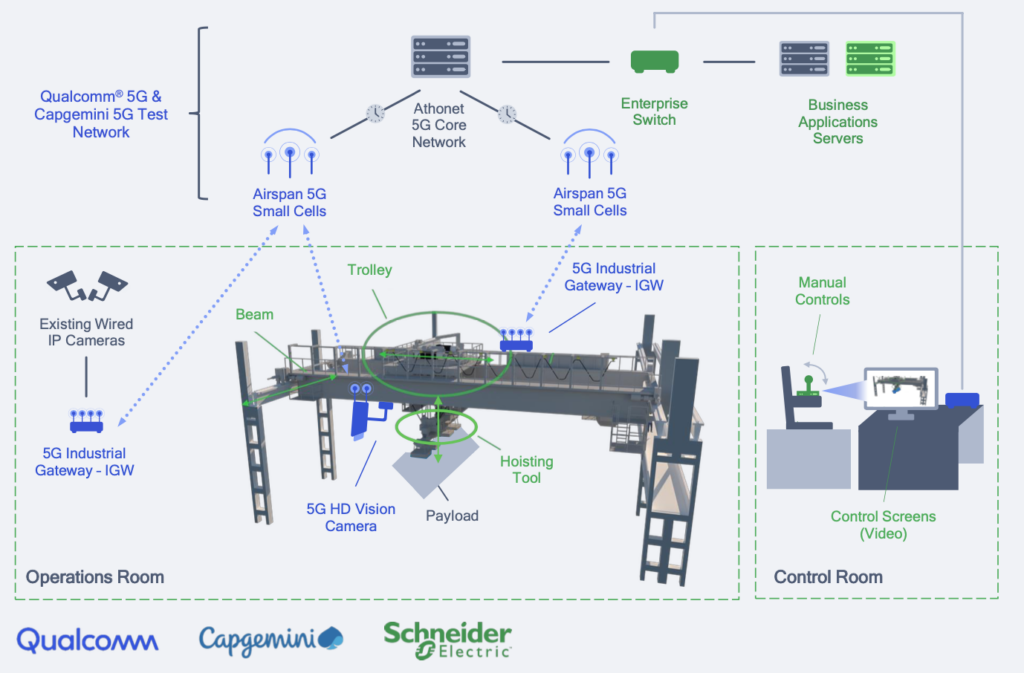
Schneider VP of Innovation and Upstream Marketing Marc Lafont emphasized the importance of an ecosystem in developing solutions to address the needs of different industries. He said in a statement that Schneider “has always been a proponent of collaboration and the innovation that comes with it. This breakthrough end-to-end 5G private network hoisting solution is a perfect example of the power of working together as we pilot it at end user sites this year. In the short term, we will validate more industrial 5G use cases in various discrete manufacturing, hybrid automation, and process automation applications. In the mid term, we will experiment with deeper integration of 5G technology inside our automation equipment.”
Back again to Giaretta to reiterate the big takeaway: “In the last two years and a half, it’s always been a little bit more, a little bit more, a little bit more.” Now, “Things are clear and working live…things people were saying were impossible to do with Open RAN. The technology is there. We are working with partners to bring that technology into the market. We have adoption of the technology from vendors and operators.”

